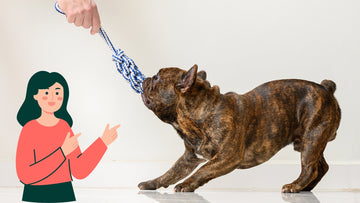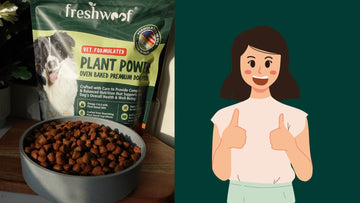Rainy days, sweltering heat, or the icy chill of winter can make outdoor activities challenging for your furry friend. However, keeping your dog active indoors is not only possible but can be a lot of fun! Here’s a guide to indoor exercises that will help maintain your dog’s physical health, mental stimulation, and emotional well-being.
Why Indoor Exercise is Important
- Physical Health: Regular exercise helps maintain a healthy weight and prevents obesity-related issues such as diabetes, heart disease, and joint problems. Indoor activities ensure your dog stays fit even when outdoor play isn't an option.
- Mental Stimulation: Dogs need mental challenges to stay sharp and happy. Indoor exercises provide opportunities for mental stimulation, reducing boredom and the likelihood of destructive behaviors.
- Emotional Well-being: Keeping your dog engaged with indoor activities helps alleviate stress and anxiety. A well-exercised dog is generally happier and more relaxed, even when stuck inside.
Fun Indoor Exercises for Dogs
- Hide and Seek: Engage your dog’s natural hunting instincts with a game of hide and seek. Hide somewhere in your home and call your dog’s name. When they find you, reward them with a treat or lots of praise. You can also hide their favorite toys or treats around the house and let them sniff them out.
- Tug-of-War: Tug-of-war is a great way to burn off energy and strengthen muscles. Use a sturdy, dog-safe rope or toy and play a friendly game. Remember to let your dog win occasionally to keep them motivated. This game is perfect for small spaces and requires minimal setup.
- Fetch: Yes, fetch can be an indoor game too! Use soft, lightweight toys to avoid breaking anything. Hallways or spacious living rooms work best. Throw the toy and let your dog chase and retrieve it. Just watch out for those enthusiastic skids and slides!
- Puzzle Toys: Interactive puzzle toys are fantastic for mental stimulation. These toys require your dog to think and solve problems to access treats hidden inside. There are various types available, from treat-dispensing balls to more complex puzzles. They’re perfect for keeping your dog occupied and mentally sharp.
- Staircase Workout: If you have stairs, use them for a great workout. Stand at the top and throw a toy down, encouraging your dog to fetch it and bring it back up. This provides an excellent cardio workout and strengthens muscles. Ensure your dog is comfortable with stairs and monitor them to prevent accidents.
- Indoor Obstacle Course: Set up an obstacle course using household items like chairs, cushions, and boxes. Guide your dog through the course, encouraging them to jump over or crawl under obstacles. This not only provides physical exercise but also improves their agility and coordination.
- Training Sessions: Use indoor time to teach your dog new tricks or reinforce basic commands. Training sessions are mentally stimulating and help strengthen your bond. Tricks like rolling over, playing dead, or even advanced obedience commands keep your dog engaged and challenged.
- Dance Party: Turn up the music and have a little dance party with your dog. Encourage them to jump, spin, or follow you around. It’s a fun way to get both you and your dog moving. Plus, who can resist a dancing dog?
- Tug-a-Jug: Tug-a-Jug toys are designed to dispense treats as your dog plays with them. These toys provide both mental and physical stimulation, as your dog has to figure out how to manipulate the toy to get the treats out. It’s a great way to keep your dog entertained and active indoors.
- Scent Work: Hide treats or toys around the house and let your dog find them using their nose. This game taps into their natural sniffing instincts and provides excellent mental stimulation. Start with easy-to-find spots and gradually make the hiding places more challenging.
Tips for Indoor Exercise
- Know Your Space: Consider the size and layout of your home. Choose activities that fit your space without causing damage or creating hazards. Hallways, living rooms, and basements can be great areas for indoor play.
- Safety First: Ensure the space is safe for active play. Move breakable items out of the way and secure loose rugs or furniture that could be knocked over. Supervise your dog during play to prevent accidents.
- Vary the Activities: Mix up the activities to keep your dog engaged. Just like humans, dogs can get bored with the same routine. Rotating different games and exercises keeps things interesting and challenging.
- Watch for Signs of Fatigue: Even indoors, dogs can get tired. Watch for signs of overexertion such as heavy panting, drooling, or reluctance to continue. Allow your dog to rest and provide water as needed.
- Use Positive Reinforcement: Always use positive reinforcement to encourage your dog. Praise, treats, and affection make the exercises more enjoyable and strengthen your bond with your dog.
Conclusion
Indoor exercise is essential for keeping your dog healthy and happy, especially when outdoor activities are not possible. With a little creativity and effort, you can provide your dog with plenty of physical and mental stimulation indoors. So, grab those toys, set up an obstacle course, and have fun! Your dog will love the extra attention and activity, and you’ll both enjoy the benefits of a well-exercised, content pup





